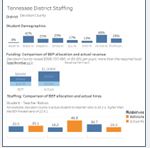More Funding Needed to Fix Tennessee Staffing Shortages
October 2020
Tennessee’s school funding formula does not adequately support the state’s schools. This report analyzes the impact of underfunding on staffing levels and the resulting inequities created between high- and low-income school districts. The state’s school formula funding, even when supplemented by local funding above the required local share, results in lower staffing levels in poorer districts in nearly every staffing category. Our findings show: (1) Nearly all districts raise more local funds than required. (2) Wealthier districts supplement with local funds to reduce the average state student-teacher ratio of 23:1 ratio to 19-20 students per teacher, while the poorest districts average a student-teacher ratio of 24:1. (3) The English language learner to English as a second language teacher ratio is twice as high in poor districts than in wealthier districts. (4) Many districts have extremely limited access to student support staff such as social workers, counselors, and psychologists.

Tennessee District Staffing, Funded and Actual
View Tennessee district staffing levels based on state funding formula (BEP) allocations and actual staffing. District-level graphics also display district student demographics.